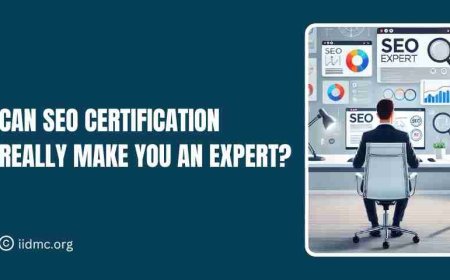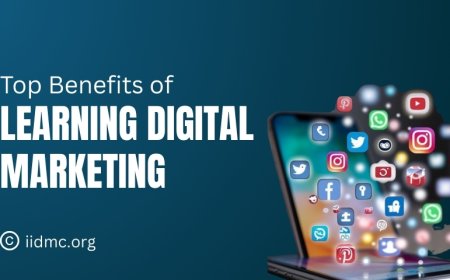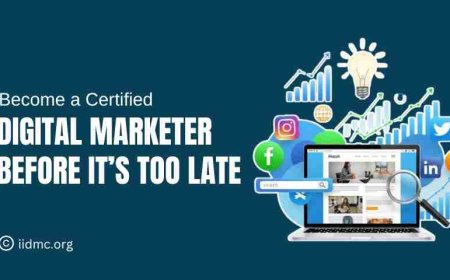Top Skills for a Google Ads Specialist Role
"Discover the top skills every Google Ads Specialist needs, from keyword research and ad copywriting to campaign optimization. Master these essentials to boost ad performance and ROI.

A Google Ads Specialist plays a crucial role in improving targeted traffic and maximizing ROI for businesses through effective online advertising strategies. In this competitive world, mastering key skills is essential for success. From expertise in keyword research to proficiency in campaign optimization, a Google Ads Specialist must continuously refine their abilities to stay ahead. In this blog, we’ll explore the top skills required for excelling in the Google Ads Specialist role and how each one contributes to achieving advertising goals efficiently.
Role of a Google Ads Specialist?
A Google Ads Specialist is a professional responsible for managing and optimizing Google Ads campaigns for businesses. Their primary role is to create effective advertising strategies that improve traffic, generate leads, and increase conversions through Google's paid advertising platform. This includes tasks like:
-
Keyword research: Identifying the right keywords for ad targeting.
-
Ad creation: Designing compelling ad copy and visuals.
-
Bid management: Setting and adjusting bids for ads to optimize performance.
-
Performance analysis: Monitoring campaign metrics and adjusting strategies for better results.
-
Budget management: Ensuring the advertising budget is spent efficiently.
Google Ads Specialists often work for digital marketing agencies, in-house teams, or as freelancers. They must have strong analytical skills, a deep understanding of Google Ads, and the ability to optimize campaigns based on data.
Keyword Research and Selection
Thorough keyword research is essential for ensuring ad relevance, as it helps target the right audience at the right time. By selecting the most relevant keywords, Google Ads Specialists can align ads with users’ search intent, increasing the chances of higher click-through rates and conversions. Tools like Google Keyword Planner are invaluable for identifying high-performing keywords and estimating their traffic potential. Using long-tail keywords which are more specific and less competitive can improve targeting accuracy while helping to manage costs by reducing competition for comprehensive, high-cost keywords.
Campaign Setup and Management for Google Ads
-
Understanding Campaign Structure
-
Account: The top-level entity where all campaigns are managed. Each account has a unique login and billing information.
-
Campaign: The next level, where specific goals and settings (such as location targeting and budget) are defined. Each campaign can have multiple ad groups.
-
Ad Groups: Contain ads and keywords. Ad groups allow you to organize ads and keywords into themes to target specific audiences effectively.
-
Best Practices for Campaign Setup
-
Define Clear Objectives: Align your campaign structure with your marketing goals (e.g., increasing sales, generating leads).
-
Organize Ad Groups: Create tightly themed ad groups with relevant keywords and ad copy to improve quality scores and ad relevance.
-
Use Relevant Keywords: Perform thorough keyword research to select terms that match your target audience's search intent.
-
Set Targeting Options: Use geographic, demographic, and behavioral targeting to reach your ideal audience effectively.
-
Craft Compelling Ads: Write clear, convincing ad copy and use high-quality visuals to attract clicks and improve conversions.
-
Importance of Ongoing Management and Optimization
-
Monitor Performance: Regularly review campaign performance metrics (e.g., click-through rate, conversion rate) to gauge effectiveness.
-
Adjust Bids and Budgets: Optimize bids and budgets based on performance data to ensure cost-efficiency.
-
Test and Iterate: Conduct A/B testing on ads and keywords to determine what works best and make data-driven improvements.
-
Respond to Changes: Stay updated with Google Ads platform changes and market trends to keep your campaigns relevant and competitive.
Effective campaign setup and management are crucial for maximizing the ROI of your Google Ads efforts and achieving your marketing objectives.
Ad Copywriting for Google Ads
-
Crafting Compelling Ad Copy
-
Headline: Create a clear, attention-grabbing headline that includes relevant keywords. It should be concise and directly address the user’s search intent.
-
Description: Write a compelling description that highlights the benefits or unique selling points of your product or service. Use persuasive language to encourage clicks.
-
Call to Action (CTA): Include a strong CTA to prompt users to take the desired action, such as “Buy Now,” “Learn More,” or “Get a Quote.”
-
Using A/B Testing
-
Test Variations: Create multiple versions of ad copy to test different headlines, descriptions, and CTAs. A/B testing helps identify which elements perform best.
-
Analyze Results: Monitor metrics such as click-through rate (CTR), conversion rate, and cost per acquisition (CPA) to determine the effectiveness of each ad variation.
-
Iterate and Improve: Use the insights gained from testing to refine and optimize your ad copy continuously for better performance.
-
Importance of Matching Ad Messaging to Audience Intent
-
Relevance: Ensure that your ad copy aligns with the user’s search intent and query. Ads should address the specific needs or problems users are searching to solve.
-
Consistency: Maintain consistency between your ad copy and the landing page content to provide a seamless user experience. This helps in improving Quality Score and conversion rates.
-
Personalization: Tailor your messaging to different audience segments to make your ads more relevant and engaging.
Effective ad copywriting is essential for capturing user interest, driving clicks, and increasing conversions. By crafting compelling ads, utilizing A/B testing, and aligning messaging with audience intent, you can enhance your Google Ads campaign performance.
Data Analysis and Reporting
-
Analyzing Metrics
-
CTR: Measures ad relevance (clicks vs. impressions).
-
CPC: Tracks cost per click to manage budget.
-
Conversion Rate: Indicates how well ads drive actions.
-
Using Google Analytics
-
Track Performance: Monitor user behavior and conversions.
-
Inform Decisions: Use data insights for campaign tweaks.
-
Integration: Link Google Ads with Analytics for complete data.
-
Presenting Insights
-
Detailed Reports: Highlight key metrics and trends.
-
Actionable Recommendations: Provide clear, data-driven suggestions.
-
Stakeholder Communication: Tailor reports to stakeholders' needs.
Bid Management and Budget Optimization
-
Automated vs. Manual Bidding
-
Automated Bidding: Uses Google’s algorithms for real-time adjustments.
-
Manual Bidding: Allows manual bid setting for greater control.
-
Optimizing Ad Spend
-
Bid Adjustments: Modify bids based on performance factors.
-
Negative Keywords: Exclude irrelevant searches to save budget.
-
Campaign Segmentation: Allocate budget to high-performing segments.
-
Adjusting Bids
-
Performance Review: Increase bids for top-performing keywords.
-
Competitive Analysis: Adjust bids based on competitor actions.
Conversion Rate Optimization (CRO)
-
Landing Page Relevance
-
Optimization: Ensure landing pages match ad messaging and user expectations. Improve elements like design, content, and call-to-action (CTA) to boost conversions.
-
User Experience: Create a seamless and engaging experience with fast load times and clear navigation.
-
A/B Testing Strategies
-
Test Variations: Experiment with different headlines, images, and CTAs to determine what drives higher conversion rates.
-
Analyze Results: Use data to identify the most effective elements and make informed improvements.
-
Aligning Google Ads with CRO
-
Consistency: Ensure ad copy and landing pages are aligned to meet user expectations and drive relevant traffic.
-
Refinement: Use insights from CRO efforts to adjust Google Ads strategies, such as targeting and bidding, to enhance overall campaign performance.
Staying Updated on Google Ads Features and Policies

-
Constant Learning
-
Updates: Regularly check Google Ads blog and official resources for the latest updates and policy changes.
-
Newsletters: Subscribe to industry newsletters to receive updates directly.
-
Adapting to New Features
-
Competitive Edge: Accept new features and tools as they become available to stay ahead of competitors and optimize campaign performance.
-
Innovation: Implement new strategies and technologies to enhance ad effectiveness and reach.
-
Resources and Training
-
Google Skillshop: Access Google’s training platform for courses on new features and best practices.
-
Webinars and Workshops: Participate in industry webinars and workshops to gain insights and practical knowledge.
-
Online Communities: Join forums and social media groups for discussions and tips from other professionals.
To excel as a Google Ads Specialist, focusing on key skills such as thorough keyword research, compelling ad copywriting, and effective A/B testing is crucial. These skills help ensure your ads are relevant, engaging, and optimized for the best possible performance and ROI.
As the digital advertising landscape evolves, continuous learning and skill development are essential. Consider exploring certification opportunities from institutions like IIDMC (International Institute of Digital Marketing and Certification) to stay updated and enhance your expertise in the field.




























